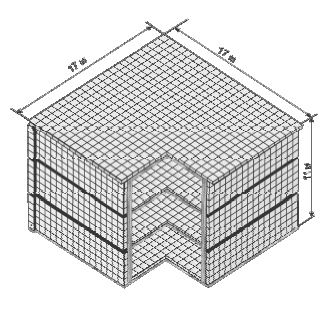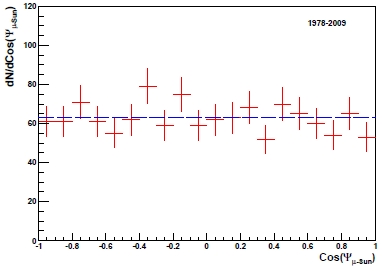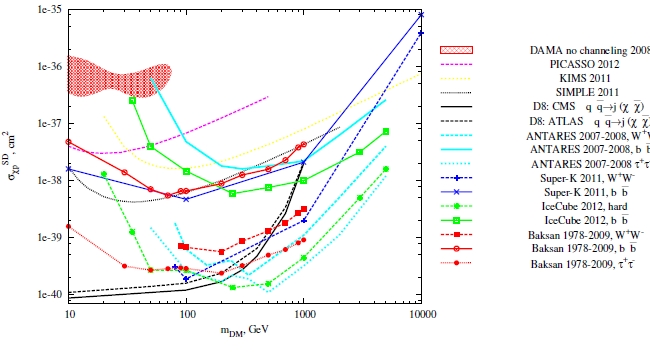BUST is a detector made of 3150 tanks (approx. 28"x28"x12") of liquid scintillator, arranged in a structure of 17x17x11 meters (see picture below, left). It is located underground at an altitude of 1700 meters. There, the flux of secondary cosmic-ray muons coming from the upper atmosphere is a million times higher than the flux of upward-going ones generated by neutrino interactions in the earth core: by looking at upward-going muons (with energy above 1 GeV) tracing back to the position of the sun, BUST can detect a signal of energetic neutrinos coming from the sun core, thereby evidencing a possible signal of annihilation of dark matter particles.
 The idea is the following: if dark matter in the universe is due to some kind of massive stable particle, remained as a relic of the big bang and clustering in the vicinity of massive objects by gravitational force, then one may imagine that within the sun's core particles and antiparticles of this dark matter could annihilate, generating standard matter such as quark-antiquark or lepton-antilepton pairs, or even W-boson pairs.
The idea is the following: if dark matter in the universe is due to some kind of massive stable particle, remained as a relic of the big bang and clustering in the vicinity of massive objects by gravitational force, then one may imagine that within the sun's core particles and antiparticles of this dark matter could annihilate, generating standard matter such as quark-antiquark or lepton-antilepton pairs, or even W-boson pairs. From here on it is standard physics: A fraction of these decay products would then in turn decay into muon neutrinos, which could escape from the sun interior, eventually reaching the earth. Most of these neutrinos would cross the earth without being stopped, but occasionally a neutrino-nucleon interaction could give rise to a muon. A muon generated shortly before the neutrino reached BUST could manage to punch through the remaining matter, finally traversing the scintillating material and yielding a detectable signal. Energetic neutrinos from the annihilation of massive dark-matter particles (10 GeVs and up) would give rise to muons that would remain in the originary trajectory: this way, a detected upward-going muon in BUST would be pointing away from the sun, and would thus be discernible from muons arriving from other sources.
 Baksan detected muons with upward-going triggers almost incessantly in the last 34 years, for a record 24.1 years of live time! During this exceptionally long exposure, the collected data were analyzed to reject signals from downward-going muons (which are produced for the largest part when protons and light nuclei of cosmic origin hit the upper atmosphere, generating a shower of secondaries among which muons constitute the most penetrating component). A total of 1255 clean upward-going muons were finally selected (and individually scanned to verify their quality!). One can then look at the direction of arrival of these particles with respect to the sun position, or better, the cosine of the angle of arrival. It is shown in the graph on the right.
Baksan detected muons with upward-going triggers almost incessantly in the last 34 years, for a record 24.1 years of live time! During this exceptionally long exposure, the collected data were analyzed to reject signals from downward-going muons (which are produced for the largest part when protons and light nuclei of cosmic origin hit the upper atmosphere, generating a shower of secondaries among which muons constitute the most penetrating component). A total of 1255 clean upward-going muons were finally selected (and individually scanned to verify their quality!). One can then look at the direction of arrival of these particles with respect to the sun position, or better, the cosine of the angle of arrival. It is shown in the graph on the right.One notices no enhancement of muons coming directly from the sun (at cos(theta)=1). This indicates that there is no potential signal of dark matter annihilation.
The data is used to place an upper limit on the flux of neutrinos from dark matter annihilations. From this upper limit, one can derive an upper limit on the cross section of dark matter scattering off protons, a number which is the one most commonly reported by dark matter search experiments which look at the recoil of nuclei off dark matter. The trick is to consider a situation of equilibrium, where the flux of dark matter particles captured in the sun core and the rate of annihilation compensate each other: the equilibrium condition allows one to relate the annihilation rate to the scattering cross section.
BUST can thus report their findings in the graph below and compare their performance to other experiments that more specifically target dark matter searches. The curves of different colour are upper limits on the spin-dependent elastic cross section of dark matter and protons, plotted as a function of the unknown mass of the dark matter corpuscles. You can see how the BUST results compare favourably with other searches; the three red curves show computed limits assuming that annihilations generate different particle pairs. The produced final state particles in turn produce neutrinos with different energy spectra and different efficiency (due to their own branching fractions into neutrinos), thus generating different upper limits once the detector acceptance and all other factors are accounted for.
Interestingly, the recent results of LHC searches for dark matter signals -which are pair-production cross section limits of dark matter particles- can also be converted into DM-proton scattering cross sections, if some theoretical assumptions are made. In that case, the CMS results are so far the most constraining ones (black curve).

In summary, BUST provides an interesting bit of information in these searches of dark matter signals. Every such search in fact is subject to different assumptions, and the orthogonality of the different techniques is a very important and robust ingredient in our reading of the results. Plus, I must say I find it totally awesome that a pile of liquid scintillation tanks -a neutrino telescope- has been observing the sun for over thirty years, and can report today results which are of comparable quality to those obtained more recently by detectors built with a technology which was not even conceivable in 1978!



Comments